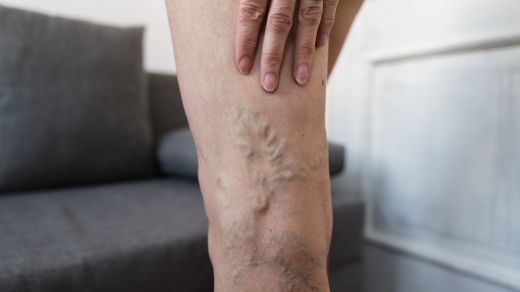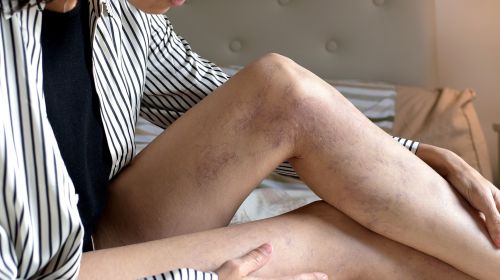Varicose veins are considered to be medically unproblematic and do not need to be removed as long as no symptoms occur. Only if the blue, nodular vessels cause pain or other discomfort should they be treated. Read all about the different methods and how you can prevent varicose veins.
- © Getty Images/OLEKSANDRA TROIAN
Quick overview: Frequently asked questions and answers
Are varicose veins dangerous? Many people find varicose veins unsightly, but they are usually not dangerous. However, they can lead to problems such as pain or skin changes. In rare cases, they cause more serious health problems such as phlebitis or thrombosis.
What are the causes of varicose veins? Varicose veins are caused by weak vein valves and walls. Factors such as heredity, standing or sitting for long periods of time, obesity, and pregnancy can increase the risk of varicose veins.
What can you do about varicose veins? To prevent varicose veins or relieve symptoms, regular exercise, elevating your legs and wearing compression stockings as well as maintaining a healthy body weight help. If the symptoms are more severe or for aesthetic reasons, medical treatments such as vein stripping, sclerotherapy or laser therapy can be considered.
Are spider veins a precursor to varicose veins? Spider veins can develop into varicose veins and indicate a venous disease, although in many cases it often only remains as spider veins. Varicose veins usually occur in larger veins.
Article contents at a glance:
What are varicose veins?
Varicose veins are knotty, bulging veins in which blood flow is restricted. They are also known in technical language as varicosis or varicosity.
From a medical perspective, varicose veins are harmless in most cases and do not require medical treatment. This also applies to the so-called spider veins, a precursor to varicose veins.
The term varicose vein comes from the Middle High German term “Krummader”, because the veins are tortuous.
Varicose veins: what symptoms occur?
In most cases, varicose veins develop on the legs, especially on the calves, the backs of the knees and the inside of the thighs (magna saphenous vein).
Varicose veins are primarily a cosmetic problem as the veins protrude outward and can appear bluish-purple through the skin.
Other possible symptoms of varicose veins include:
- Pains
- heavy, swollen legs
- Tightness or itching of the skin
- sometimes pain or leg cramps at night
Varicose veins can also occur on the testicles or labia. Basically there are also enlarged ones Hemorrhoids Varicose veins. These are dilated blood vessels at the anus, which can cause pain or bleeding.
Complications from varicose veins
If varicose veins are left untreated, various complications can arise. Most often, those affected develop a so-called “open leg” (ulcus cruris), an ulcer on the lower leg.
Inflammation of the veins and, as a result, dangerous blood clots (thrombi) are less common. A leg vein thrombosis always needs to be treated. If such a blood clot breaks off, it is transported further in the bloodstream and can block blood vessels elsewhere in the body. In the worst case scenario, there is a risk of a dangerous pulmonary embolism.
Diagnosis: How are varicose veins diagnosed?
If varicose veins and symptoms are severe, you should visit your family doctor. Superficial varicose veins can usually be diagnosed through a physical examination. Under certain circumstances, a referral will be made to a phlebologist who specializes in veins.
Duplex sonography: look into the venous system
Of central importance in the diagnosis is the question of whether deep leg veins are pathologically altered. To determine this, color-coded duplex sonography is now the method of choice.
This is a painless and risk-free ultrasound examination that can show changes in the venous system and older as well as recent thromboses. The direction of flow and the flow speed of the blood can also be measured.
Further examination methods for varicose veins
In certain cases, other imaging procedures are used for varicose veins, such as:
Phlebography, an X-ray examination of the leg veins with contrast material
MRI phlebography without X-rays
Light reflection rheography (LRR) with infrared light sources
Venous occlusion plethysmography (VVP), an examination using a pressure cuff procedure
Treatment: How can varicose veins be removed?
Most varicose veins do not cause any symptoms. If complications occur in the form of pain, swelling or bleeding, they should be treated professionally to prevent thrombosis and tissue damage. Conservative and surgical methods are available for this.
Conservative therapy for varicose veins
Conservative measures alone do not cause varicose veins to regress. However, they can relieve symptoms and ensure that the varicose veins do not get worse. The most important things are:
Compression therapy: Wearing special stockings or bandages puts pressure on the leg veins, which improves blood flow to the heart.
Venous gymnastics: A lot of exercise activates the muscle pump and also promotes blood flow. However, standing or sitting for long periods should be avoided. It is best to put your legs up when sitting.
Herbal remedies can also be used to treat varicose veins that do not yet cause any symptoms. Preparations with extracts of red vine leaves, horse chestnut, butcher’s broom rhizome and Japanese cord tree are used for venous insufficiency. However, such agents can only be used as a supplement to standard therapy.
Surgically remove varicose veins
If the varicose veins cause symptoms or if deep leg veins are affected, various surgical methods are available:
Vein stripping (“Pulling”): Pulling the varicose vein is currently the method of choice to remove extensive varices on the saphenous veins. The vein is completely pulled out through an incision in the groin. The costs are covered by the health insurance companies.
Phlebectomy/miniphlebectomy (according to Muller): Phlebectomy is also called the hook method or crochet procedure. An instrument with a hook is inserted through small incisions in the skin and the vein is removed in several parts.
Radiofrequency and laser therapy: The veins are destroyed using heat. Radiofrequency therapy uses electromagnetic waves for this purpose, while laser therapy uses high-energy laser light.
desolation (Sclerotherapy): A substance injected into the veins causes the inner walls of the vessels to become inflamed and stick together. As a result, the vein closes. The method is particularly suitable for small varicose veins and spider veins.
Fibrin glue: The affected vein is closed using a catheter with fibrin glue. There is no long-term experience yet and the assumption of costs must be clarified individually with the health insurance company.
Transillumination-assisted vein removal: A device is inserted into the affected vein under light control, then destroys the affected section of the vein and suctions it out.
Chiva method: Using ultrasound, the affected section of vein is located and then removed through a skin incision. The method is considered very gentle, but no meaningful long-term results are yet available.
Specialists in phlebology or vascular surgery should remove varicose veins. After most procedures, compression bandages or compression stockings must be worn for a few weeks.
Causes of varicose veins
There are various risk factors why veins develop into varicose veins. This includes:
- genetic predisposition
- hormonal changes during pregnancy and menopause or due to the pill
- Lack of exercise
- Overweight
- Smoke
- increasing age
- heavy strain on the legs, for example due to being overweight or standing frequently for long periods of time
In many cases, the tendency to develop varicose veins and general venous weakness is genetically determined. Many people experience vascular weakness and damage in the superficial and deeper veins, especially as they get older. The obstructed blood flow then causes varices to form over time.
However, there are also diseases that increase the pressure in the venous system and can promote the development of varicose veins. This includes:
- deep vein thrombosis of the leg
- congenital narrowing or occlusion of the large abdominal vein
- Cirrhosis of the liver
- Heart failure (right heart failure)
Varicose veins during pregnancy
The development or worsening of varicose veins during pregnancy can primarily be attributed to hormonal changes: The hormone progesterone is released more to make the tissue, especially the uterus, more elastic.
However, the connective tissue and the vein walls also become more elastic. This makes it more difficult for the venous blood to be transported back from the legs to the heart.
As the pregnancy progresses, the growing uterus puts pressure on the veins in the pelvic area and further impairs the blood flow that is increased during pregnancy.
One in three women develop varicose veins during pregnancy. After childbirth, varicose veins resolve on their own in over 90 percent of affected women within a week of giving birth.
Prevent varicose veins
In most cases, the tendency to develop varicose veins and general venous weakness is genetic. But even those who already suffer from venous insufficiency can minimize the symptoms through an active lifestyle.
The following tips can help strengthen your veins and prevent varicose veins:
sufficient exercise and endurance sports
Normal weight
cold showers for the legs
Avoid long sunbathing and sauna sessions
Avoid tight, constricting clothing
Flat shoes, if possible go barefoot a lot
Do not cross your legs when sitting
Exercises for the veins
The most important thing is to keep moving every now and then, especially when standing or sitting for long periods of time is unavoidable. Small exercises that stimulate the muscle pump and strengthen the veins can be easily incorporated into everyday life:
When standing for long periods, it can be helpful to occasionally go up on your toes and then lower your heels again after a short while. This should be repeated several times.
Circular movements with the feet, whether sitting or standing, are also recommended and can easily be carried out at the desk in the office.
Lying on your back with your legs stretched in the air and performing movements reminiscent of cycling supports the good return of blood from the legs.



